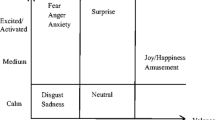Abstract
In this work, we perform an approach to emotion recognition from Electroencephalography (EEG) single channel signals extracted in four (4) mother-child dyads experiment in developmental psychology. Single channel EEG signals are decomposed by several types of wavelets and each subsignal are processed using several window sizes by performing a statistical analysis. Finally, three types of classifiers were used, obtaining accuracy rate between 50% to 87% for the emotional states such as happiness, sadness and neutrality.
Preview
Unable to display preview. Download preview PDF.
Similar content being viewed by others
References
Cabanac Michel, Cabanac Michel. What is emotion? Behavioural processes. 2002;60:69–83.
Scherer K. R.. What are emotions? And how can they be measured? 2005.
Affrunti Nicholas W., Woodruff-Borden Janet. The effect of maternal psychopathology on parentchild agreement of child anxiety symptoms: A hierarchical linear modeling approach Journal of Anxiety Disorders. 2015;32:56 - 65.
Kleiman Evan M., Ammerman Brooke, Look Amy E., Berman Mitchell E., McCloskey Michael S.. The role of emotion reactivity and gender in the relationship between psychopathology and self-injurious behavior Personality and Individual Differences. 2014;69:150 - 155.
Martínez-Miranda Juan, Aldea Arantza. Emotions in human and artificial intelligence Computers in Human Behavior. 2005;21:323 - 341.
Kreps Gary L., Neuhauser Linda. Artificial intelligence and immediacy: Designing health communication to personally engage consumers and providers Patient Education and Counseling. 2013;92:205 - 210.
Milton A., Selvi S. Tamil. Class-specific multiple classifiers scheme to recognize emotions from speech signals 2014;28:727 - 742.
Feng Xiaoyan, Watada Junzo. Building a Recognition System of Speech Emotion and Emotional States 2013 Second International Conference on Robot, Vision and Signal Processing. 2013;0:253-258.
Kenny D.A., Kashy D.A., Cook W.L.. Dyadic Data Analysis. Methodology in the social sciencesGuilford Press 2006.
Killeen Lauren A.. Understanding parenting as a process: Frontal EEG alpha asymmetry as a measure of "online" maternal responsiveness to infant cues
Castro Martinez Jaime Alberto. Neurodinámica y autoorganización en la interacción socioemocional madre-hijo: aproximación de los sistemas dinámicos a los principios del desarrollo emocional infantil ;2:17.
Castro Martinez Jaime Alberto. Sistemas dinámicos en la interacción emocional madre-hijo: primera fase ;9:129-138.
Sanei Saeid, Chambers Jonathon. a.. EEG Signal Processing;1 . 2007.
Teplan Michal. Fundamentals of EEG measurement Measurement Science Review. 2002;2:1–11.
Petrantonakis Panagiotis C, Hadjileontiadis Leontios J. Emotion recognition from EEG using higher order crossings. IEEE transactions on information technology in biomedicine : a publication of the IEEE Engineering in Medicine and Biology Society. 2010;14:186–197.
Lee You Yun, Hsieh Shulan. Classifying different emotional states by means of eegbased functional connectivity patterns PLoS ONE. 2014;9.
Varun Bajaj Ram Bilas Pachori. Classification of human emotions based on multiwavelet transform of EEG signals 2012.
Murugappan Murugappan. Classification of human emotion from EEG using discrete wavelet transform 2010.
Gomez Alejandro, Quintero Lucia, Lopez Natalia, Castro Jaime. An approach to emotion recognition in single-channel EEG signals: a mother child interaction. XX Congreso Argentino de Bioingeniería, SABI 2015. 2015.
Nason G. P., Silverman B. W.. The Stationary Wavelet Transform and some Statistical Applications :281–300Springer-Verlag 1995.
Campo D, Quintero O L, Bastidas M. Multiresolution analysis (discrete wavelet transform) through Daubechies family for emotion recognition in speech. Journal of Physics: Conference Series. 2016;705:12034.
Bustamante P A, Celani N M Lopez, Perez M E, Montoya O L Quintero. Recognition and regionalization of emotions in the arousal-valence plane Conf Proc IEEE Eng Med Biol Soc. 2015:6042–6045.
Kevin P. Balanda H. L. MacGillivray. Kurtosis: A Critical Review The American Statistician. 1988;42:111-119.
Dougherty Geoff. Pattern Recognition and Classification;53 . 2013.
James Gareth, Witten Daniela, Hastie Trevor, Tibshirani Robert. An Introduction to Statistical Learning;103 . 2013.
Author information
Authors and Affiliations
Editor information
Editors and Affiliations
Rights and permissions
Copyright information
© 2017 Springer Nature Singapore Pte Ltd.
About this paper
Cite this paper
Gómez, A., Quintero, L., López, N., Castro, J., Villa, L., Mejía, G. (2017). An approach to emotion Recognition in Single-channel EEG Signals using Stationary Wavelet Transform. In: Torres, I., Bustamante, J., Sierra, D. (eds) VII Latin American Congress on Biomedical Engineering CLAIB 2016, Bucaramanga, Santander, Colombia, October 26th -28th, 2016. IFMBE Proceedings, vol 60. Springer, Singapore. https://doi.org/10.1007/978-981-10-4086-3_164
Download citation
DOI: https://doi.org/10.1007/978-981-10-4086-3_164
Published:
Publisher Name: Springer, Singapore
Print ISBN: 978-981-10-4085-6
Online ISBN: 978-981-10-4086-3
eBook Packages: EngineeringEngineering (R0)




